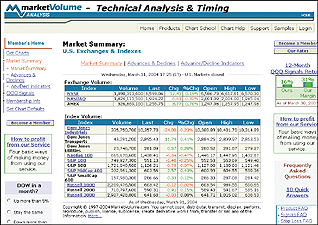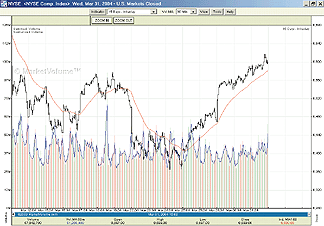MARKETVOLUME.COM
In the secular trinity of technical analysis ("the Price, the Volume, and the Passage of Time"), volume is included for good reason. While there can be no market without price, there can also be no price movement - and thus, no profit - without a pricing mechanism. I'll never forget seeing legendary Austrian economist F.A. Hayek in a PBS interview from the late 1970s criticizing socialism for having, at root, no way to determine the price of anything. The absence of a pricing mechanism -- or, more accurately, the substitution of a bureaucratic official or department for a real pricing mechanism -- was one major reason why nations like the Soviet Union continuously suffered from shortages, in spite of their productive capacity. How many apples would you sell if the price was supplied not by buyers and sellers of apples, but by some committee half a country away?
Fortunately for capitalists and market participants, we do have a pricing mechanism, and that pricing mechanism is most clearly expressed by volume. What is volume in the context of markets? Volume represents the actual supply and demand that moves prices higher and lower. As technical analyst John J. Murphy observed in his book, The Visual Investor:
Simple economics tells us that when demand increases relative to supply, prices rise. When supply exceeds demand, prices fall. The same principle applies to stocks, bonds, currencies, and commodities. However, how does one tell what those supply and demand figures are? The ability to tell which is greater is obviously the key to price forecasting.
While Murphy goes on to note that "the easiest way is to let the price itself tell us," with rising prices indicating greater demand and falling prices indicating greater supply, he does say later in a section on "Volume Analysis" that:
... Volume tells us a lot about the strength or weakness of the price trend. Generally speaking, when a stock price is in an uptrend, buying pressure should be greater than selling pressure. In a healthy uptrend, volume bars are generally larger when prices are rising and smaller when prices are falling. ... As a general rule of thumb, heavier volume should be evident in the direction of the existing trend.

Figure 1: SUMMARY. MarketVolume.com's market summary includes volume data on a variety of major market averages and indexes. Volume data on advancing and declining issues is also a part of this module.
MARKETVOLUME.COM WEIGHS IN
What makes MarketVolume.com unique among trading/technical analysis websites that offer market analysis and trading signals is its emphasis on volume. Focusing on the major stock market indexes - including their derivative and exchange-traded products (such as the QQQ and SPY) -- MV.com offers both a free newsletter service and a monthly paid service for traders and investors interested in the trading opportunities provided by its volume-oriented technical trading system.
What do you get as a member of MarketVolume.com? MV.com has four different membership levels, including the "free trial" level. The other three membership levels are "personal," "professional," and "business." Unlike some websites that offer only a minimum of services at the lower levels, saving all the "goodies" for the most expensive membership, MV.com is remarkably consistent across the membership levels.
The services and products that are reserved for higher membership levels include such features as pre- and post-closing trading signals; access to unique markets (American Stock Exchange and Dow Jones utilities compared to the New York Stock Exchange and the Nasdaq 100) by way of the exchange volume, index volume and MV Select volume charts; and access to a companion website, Index-Day-Trading.com. Both monthly and quarterly payment options are available to prospective subscribers. MarketVolume.com provides a helpful chart that makes clear what members get at each membership level.
The "rewards of membership" to MarketVolume.com include what MV.com calls its "Special Features." These features consist of "After-Close" and "Pre-Close" Qqq trading signals. These trading signals are generated by MarketVolume.com's volume-oriented trading system, and are geared toward medium and long-term Qqq traders and position players. They claim to produce in the neighborhood of "10/20 conservative trades" each year.
After-close and pre-close signals are differentiated chiefly by the time at which the signals are published at the MarketVolume.com website (after-close signals are posted by 7:30 pm Eastern time, while pre-close signals are posted approximately 45 minutes before the market closes). MV.com helpfully notes that pre-close signals might be especially valuable for those trading their mutual fund or 401(K) holdings who need to make "in-advance" market decisions based on the relatively restricted access to mutual fund markets. Both after-close and pre-close signals are also available as email alerts.

Figure 2: VOLUME. MarketVolume.com's JavaVolume charts are a helpful, Java-based way to visually document the changing relationship between price and volume.
MarketBreadth
MV.com's Special Features also include a Market Summary, which is subdivided into three areas: Market Summary, Advances and Declines, and Advance/Decline Indicators. The Market Summary covers US exchanges and main indexes (Nyse; Nasdaq; Amex; Dow Jones industrials, transports, and utilities; Nasdaq 100; Standard & Poor's 100, 500, MidCap 400 and SmallCap 600; and the Russell 1000, 2000, 3000). The Market Summary also includes data on volume, last price, price change and percentage change, open, and high and low. The Advances and Declines page provides data on issues that advanced or declined for the day - as well as the number of unchanged issues - and the volume for advancing, declining, and unchanged issues.
New highs and new lows are also tallied for all of the above listed exchanges and indexes, as well as for five additional categories of stocks (Nasdaq Internet, Nasdaq Market Movers, S&P Large Cap, S&P Market Leaders, and S&P Market Makers). MV.com members can also retrieve historical advance/decline information by way of pulldown menus at the bottom of the table. At present, this historical data extends back to November 2003.
The last section of the Market Summary is the Advance/Decline Indicators table. Using all of the exchanges and indexes from the Advances and Declines page, the Advance/Decline Indicators table provides market breadth information at a glance. Also with a historical data pulldown menu, the Advance/Decline Indicators table provides data on index percent change, advancers less decliners, the A/D ratio, advancing volume less declining volume, and the A/D volume ratio.
The last "Special Feature" is free access to another website run by Highlight Investment Group called Index-Day-Trading.com. This site consists principally of daily newsletters providing analysis of market trends and expectations. Each newsletter includes detailed discussion of what they refer to as "Market Stage" or long-term trends, "Market Status" or mid- to short-term trends, as well as other relevant notes and observations, and an update on any open recommendations.
Because of the different levels of analysis (from longer term to shorter term), the Index-Day-Trading.com newsletters can be relevant to both investors and position traders, as well as to short-term swing and daytraders. It should be noted that the material in the Index-Day-Trading.com's detailed discussion is apparently the same as what is provided MV.com members by way of market commentary ("daily" market commentary for paying members, "not always updated daily" for members taking advantage of the free trial).
MARKETCHARTS AND CONCLUSIONS
MarketVolume.com provides three different types of charts: Exchange Volume, Index Volume, and MV Select Volume. The "Exchange," "Index," and "MV Select" refer not so much to different types of charts as to the different information each chart provides. In other words, all three of the charts are created by MarketVolume.com's JavaVolume charts and look essentially the same. The difference is that exchange volume charts include the Nyse, Nasdaq, and Amex, while the index volume charts include the Dow Jones industrials, S&P 100, and so on. MV Select Volume Charts include those other categories mentioned previously in the Advances and Declines page (S&P Market Movers, S&P Large Cap, and so on).
The JavaVolume charts themselves are attractive, clean, and easy to read. The charts' periodicity can be switched between a number of different options - from one day/intraday real-time to five years/daily end-of-day. JavaVolume charts do not sport the dizzying array of technical indicators that many other charting programs do - they are limited mostly to various moving averages than can be applied to both price and volume.
The volume moving averages are the more wide-ranging of the two, allowing for five-, 15-, 30-, 60-, 120-, 180-, and 240-minute moving averages of volume, as well as one-, three- five-, 10-, 20-, 30-, and 60-day moving averages of volume. Other volume adjustments include options for averaged, summed, and normalized volume; and up and down volume. Price adjustments include bar, line, and percent charting options. MV.com members also have the option to resize the data by way of the "zoom-in" and "zoom-out" functions.
There is more to MarketVolume.com. In addition to a variety of detailed and informative Faqs, MV.com provides member testimonials, an archive of past trades and performance data, and links to information about MV.com's various trading systems (QQQ Options, QQQ Stock, SPDRs, Dow, and Mutual Funds).
At times, MarketVolume.com - like a number of the e-newsletters that have proliferated on the Internet in recent years - is a dizzying display of special offers, free newsletter commentaries, performance statistics, "chart schools," e-polls, and links to at least seven different FAQs. This is perhaps one of the numerous ways that MV.com's free trial is especially helpful.
Another may be this: More than a few now-legendary traders -- from Marty Schwartz to Paul Tudor Jones -- have frequently pointed out how pivotal a role that trading mentors played in their early trading careers. These days, while there may be more traders - and, it is important to note, more successful and talented traders - than there may have been in the 1970s or 1980s, finding a qualified trading mentor or tutor hasn't necessarily gotten any easier.
Websites like MV.com give traders the opportunity to trade along with a more senior partner, or even mentor - either by following MarketVolume.com's recommendations explicitly, or by using those recommendations as confirming tools for their own decisions. And with the opportunity to meet this prospective veteran partner provided by way of a free trial, why not surf over to MarketVolume.com and introduce yourself?
-David Penn, Technical Writer
SUGGESTED READING
Murphy, John J. [1996]. The Visual Investor, John Wiley & Sons.
Originally published in the June 2004 issue of Technical Analysis of STOCKS & COMMODITIES magazine. All rights reserved. © Copyright 2004, Technical Analysis, Inc.